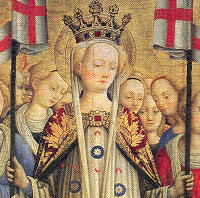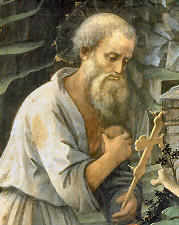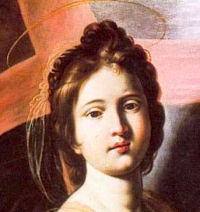Ordinary Time: October 21st
Wednesday of the Twenty Ninth Week of Ordinary Time
Other Commemorations: St. Hilarion, Abbot (RM); Saints Ursula and Companions, Virgins and Martyrs (RM) ; Other Titles: Hilary;
» Enjoy our Liturgical Seasons series of e-books!
According to the 1962 Missal of St. John XXIII the Extraordinary Form of the Roman Rite, today is the feast of St. Hilarion, who was born of pagan parents near Gaza in Palestine toward the close of the third century. He studied at Alexandria and became a Christian at the age of 15. Following the example of St. Anthony in Egypt, Hilarion resolved to become a hermit in the desert, and Anthony himself trained the youth. He gave all his possessions to the poor, and became the father of monasticism in Palestine and Syria, famous for his miracles and sanctity. He lived to be over 80, dying on the island of Cyprus in 372.
This date is also the commemoration of St. Ursula and her companions. In medieval times her legend developed into many versions; but all that may be said with certainty of these martyrs is that they suffered martyrdom at or near Cologne, and were sufficiently well known to have had a church built in their honor during the fourth century.
Sts. Ursula and Companions
According to a legend that appeared in the tenth century, Ursula was the daughter of a Christian King in Britain and was granted a three-year postponement of a marriage she did not wish to a pagan prince. With ten ladies in waiting, each attended by a thousand maidens, she embarked on a voyage across the North Sea, sailed up the Rhine to Basle, Switzerland, and then went to Rome. On their way back they were all massacred by pagan Huns at Cologne in about 451 when Ursula refused to marry their chieftain.
 According to another legend, America was settled by British colonizers and soldiers after Emperor Magnus Clemens Maximus conquered Britain and Gaul in 383. The ruler of the settlers, Cynan Meiriadog, called on King Dionotus of Cornwall for wives for the settlers, whereupon Dionotus sent his daughter Ursula, who was to marry Cynan, with eleven thousand noble maidens and sixty thousand common women. Their fleet was shipwrecked and all the women were enslaved or murdered.
According to another legend, America was settled by British colonizers and soldiers after Emperor Magnus Clemens Maximus conquered Britain and Gaul in 383. The ruler of the settlers, Cynan Meiriadog, called on King Dionotus of Cornwall for wives for the settlers, whereupon Dionotus sent his daughter Ursula, who was to marry Cynan, with eleven thousand noble maidens and sixty thousand common women. Their fleet was shipwrecked and all the women were enslaved or murdered.
The legends are pious fictions, but what is true is that one Clematius, a senator, rebuilt a basilica in Cologne that had originally been built, probably at the beginning of the fourth century, to honor a group of virgins who had been martyred at Cologne. They were evidently venerated enough to have had a church built in their honor, but who they were and how many of them there were are unknown. From these meager facts, the legend of Ursula grew and developed.
—Excerpted from Dictionary of Saints, John J. Delaney
The 11,000 number probably resulted from a misreading of the term "11M" which indicated 11 Martyrs, but which a copyist took for a Roman numeral. St. Ursula is the namesake for the Ursuline Order, founded for the education of young Catholic girls and women.
Patronage: Catholic education (especially of girls); Cologne, Germany; educators; holy death; schoolchildren; students; teachers; Ursuline order
Symbols and Representation: Large mantle lined with ermine; two arrows; three arrows; dove; book; ship; white banner charged with red cross; book and arrow; crown; pilgrim's staff; arrow and furled banner; clock; maiden shot with arrows, often accompanied by a varied number of companions who are being martyred in assorted, often creative ways
Highlights and Things to Do:
- Read more about St. Ursula and her companions
- Take a few minutes to view the beautiful paintings from the life of St. Ursula by Vittore Carpaccio at the Web Gallery of Art. There is also Hans Memling's Saint Ursula Shrine at the same site.
- See the statue of St. Ursula at St. Peter's Basilica Colonnade.
- Although there is some questioning on all the historical basis of St. Ursula and her companions, there is the Basilica of St. Ursula in Cologne which contains relics of these martyrs.
- Read this article, Cologne’s Eleven Thousand Virgins and Hildegard of Bingen: Saint Ursula’s Martyrdom in Legend and Song.
- St. Angela Merici founded the Order of Ursulines which has kept St. Ursula's devotion in the forefront.
St. Hilarion (Hilary)
 St. Hilary was born at Tabatha near Gaza, Palestine, in the year 291. His pagan parents sent him, while still a youth, to study at Alexandria. He was remarkable for his diligence and good manners, and he shortly became a convert to Christianity, making great progress in faith and charity. He was zealous in visiting churches, in fasting and prayer, in scorning all earthly joys and pleasures. Lured by the fame of St. Anthony, Egypt's illustrious hermit, he entered the desert and for two months remained his disciple. While absent, his parents died. Now Hilary gave all he had to the poor, and although hardly fifteen years old (306), he returned to the desert, built a little hut scarcely large enough to accommodate himself, and slept on the bare ground.
St. Hilary was born at Tabatha near Gaza, Palestine, in the year 291. His pagan parents sent him, while still a youth, to study at Alexandria. He was remarkable for his diligence and good manners, and he shortly became a convert to Christianity, making great progress in faith and charity. He was zealous in visiting churches, in fasting and prayer, in scorning all earthly joys and pleasures. Lured by the fame of St. Anthony, Egypt's illustrious hermit, he entered the desert and for two months remained his disciple. While absent, his parents died. Now Hilary gave all he had to the poor, and although hardly fifteen years old (306), he returned to the desert, built a little hut scarcely large enough to accommodate himself, and slept on the bare ground.
Most of his time was spent in reading and in meditating upon holy Scripture. A few figs and a little soup from herbs sufficed for his nourishment, but this he never took before the setting of the sun. Because of his mortifications and humility, he triumphed over fierce assaults by the evil one and healed many who were possessed. After founding numerous hermitages (he had two thousand followers) and working countless miracles, he became ill at the age of eighty. In his last agony he encouraged himself by saying: "Go thither, my soul, why do you fear? Why do you tremble? Seventy years you have served Christ, and now you fear death?" The day of Hilary's death is given as October 21, 371. His grave is on the island of Cyprus. St. Jerome wrote the life of the holy hermit twenty years after his death.
—Excerpted from The Church's Year of Grace, Pius Parsch
Symbols and Representation: Hour glass; basket; dragon
Highlights and Things to Do:
- Read St. Jerome's Life of St. Hilarion written in 390.
- Read more about St. Hilarion:
- See St. Hilarion's statue on St. Peter's Basilica Colonnade.






